Red Barn
Families Along the Goulburn
19 07 23 14:00 Filed in: Jim
Recently we discovered a bit more about the Molesworth branch of our dad’s family. Down the rabbit hole we went.
It took weeks to piece together the snippets of information we had. We doubled checked information, discarded red herrings, created a timeline. We complained about the way names appeared and reappeared in different generations. We cut and pasted a colour coded chart. Finally, gradually, the stories came into focus in our minds.
Our story begins in Ireland.
Four families: McCormacks, Fords, Hamiltons and Ryans
Three of the families, the McCormacks. the Fords and the Ryans, all Catholics, all emigrated about 1848 from Southern Ireland: Limerick, Galway and Tipperary
The fourth family, the Hamiltons, were Protestants, of Scottish Irish heritage. They emigrated from Antrim, Northern Ireland, also in 1848.
The Northern Irish Hamiltons arrived with some money, ready to buy land. But
our Southern IrIsh were probably driven out by the general economic turmoil and devastation caused by the Irish Potato Famine of 1845-1852.
At that time, the vast majority of the Irish Catholic population had little or no access to land ownership and many lived in appalling poverty.
Ninety percent of the land in Ireland was owned by Protestant landowners, who rented it out in small parcels to Irish tenant farmers. Already poor and dependent on the potato crop, Irish families starved when successive harvests failed, due to Potato Blight. As a result, Irish people emigrated in large numbers, land hungry and ready to and make their fortunes.
The colony the McCormacks, Fords, Hamiltons and Ryans arrived and settled in, had been ‘opened up’ by the squatters coming down from north of the Murray and inland from Portland. The Aboriginal tribes had been largely dispossessed, vast fortunes had been made, and the landed aristocracy had emerged as a powerful force in the burgeoning colony.
It is both expected and fascinating to see our Irish immigrant forbears’ land acquisition and prosperity mirrored, in the opening up of land for settlement in Victoria. This took place over several decades, primarily through a series of land acts, designed to break up the vast holdings of the squatters and encourage agricultural development, population growth, and the establishment of communities.
Between 1865 and 1890 Land Acts enabled land to be acquired at a fair price, and paid off in instalments. Specified improvements had to be made such as fencing, clearing and cultivation.
As we will see, our Irish families also benefitted from the growth and prosperity stemming from the Gold Rush. In 1851 gold was discovered in Ballarat, leading to the 1850s Gold Rush, a transformative event in Victorian history.
The colony grew rapidly in both population and economic power and our families, among others, took full advantage of the opportunities offered.
They set about the serious business of acquiring property supplying the new, lucrative, growing market with their produce. Country towns around them grew and with increased wealth, substantial civic buildings and churches were built. Railways and roads were constructed providing quicker and easier access to markets and facilitating social and family connections.
It would have been an exciting time for our four families, as they bought and developed their land holdings and participated in the civic life of the Colony of Victoria, with its own Lieutenant-Governor and elected Victorian Legislative Council.
During the first fifteen years after arriving in the colony, our four Irish Families became two couples.
1 James Hamilton and Bridget Ryan
The protestant Hamilton family from Northern Ireland comprised only a mother and son. We know that James Hamilton’s father had recently died. James was in his late teens, when he and his mother emigrated to Port Phillip, with enough capital to acquire a property in the colony. They chose Upper Plenty, which at that time was a rural area.
The Ryan family also emigrated about 1848.
About seven years later, in 1855, James Hamilton married Bridget Ryan. Bridget was a Catholic. Sue and I know something of this quandary, being daughters of a similar “mixed marriage”. The wedding was held on a property “Richland” near the Hamilton’s place at Upper Plenty. The property belonged to Mr David Johnston
Archbishop Little, who is also related to these four families and has written about them, has a bit to say about this marriage:
“… the marriage of James and Bridget was a truly valid Catholic marriage in the eyes of the Church.”
What he means here is that James would have agreed to the children of the marriage being brought up Catholics. He certainly followed through with this, even driving his wife and children to church on Sundays. Two of their daughters later became nuns.
James and Bridget stayed on for a further twelve years in Upper Plenty, where the first six of their children were born. These children included Charles, Grace, Johanna and Kate. Johanna was our Great Grandmother.
Then, in 1866, they acquired “Cremona Estate”, near present day Molesworth. They ran dairy and beef cattle and grew cereals on the rich
river flats.
Cremona homestead was "situated on the southern concave side of a great sweeping arc of the Goulburn river ….. it fronts the Whanregarwen road distant some three miles east from the present township of Molesworth" 1866:
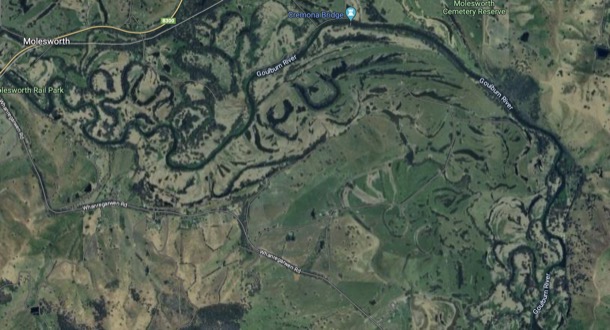
Six further children, another five of them girls, were born at Cremona, before Bridget’s death, at the age of 56, in 1889.
Archbishop Little writes glowingly of life at Cremona, and of the three eldest Hamilton girls in particular. He describes them as “charming, refined, eligible and capable young ladies.” He describes the children’s education. An in-house private tutor taught them Art, Music and Painting, as well as academic subjects. But they all helped out on the farm as well, including the older girls, Grace, Johanna and Kate.
2 John McCormack Snr and Jane Ford
We don’t know the initial activities of the McCormack and Ford families, until, in 1850, two years after landing in Port Phillip, John McCormack (Senior) married Jane Ford at St Francis Church on the corner of Lonsdale and Elizabeth streets in Melbourne. Both had been in their late twenties and unmarried when they emigrated.
St Francis church today, the oldest still operating Catholic church in Victoria:
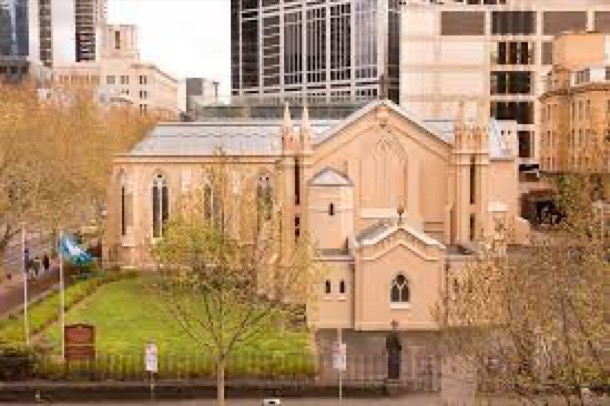
The couple settled near present day Beveridge, renting a property “Red Barn”. The property was very near the main road from Melbourne to Sydney. The family worked hard and developed a dairy herd, specialising in cheese, which they initially sold to passing diggers on their way to the goldfields.
Red Barn Lane today:
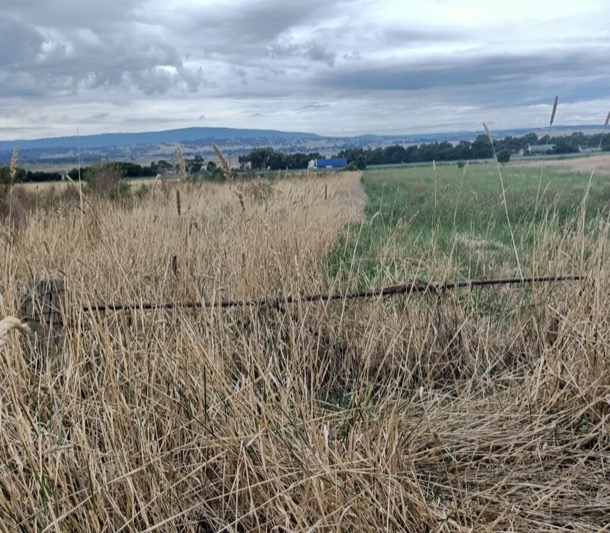
There was money to be made, so much, that the couple were later able to settle their sons on properties along the Goulburn River.
The first, of these, in 1876, was the eldest, James McCormack, then aged 18. The property, called Tallarook House, (later renamed Landscape), was at Tallarook, a hundred kilometres from Mebourne. James was unmarried at this stage and Tallarook House remained without a mistress for a further twelve years. Clearly, James was very involved in the community. He was elected as a councillor for the Shire of Seymour in 1887.
"Landscape" today:
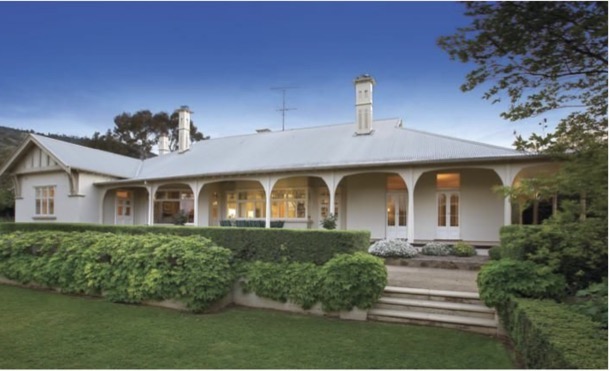
"Landscape" interior:
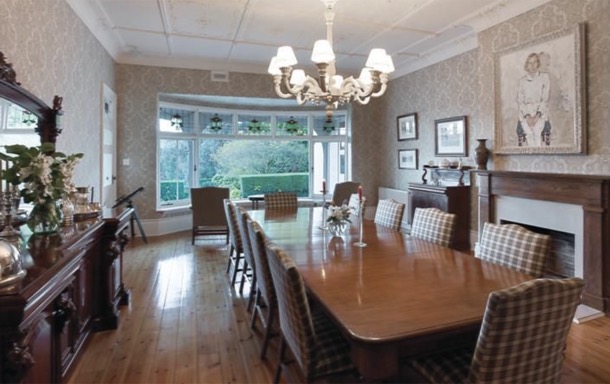
The second McCormack to be settled along the Goulburn River, was John Jnr. That property, acquired in 1886, called Balham Hill, was near Molesworth. John also became a councillor, for Yea Shire.
Balham Hill:
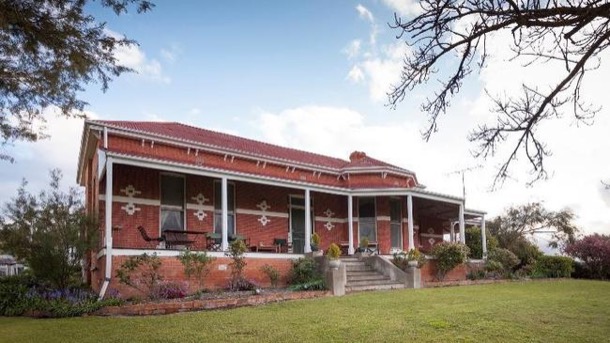
Balham Hill property:
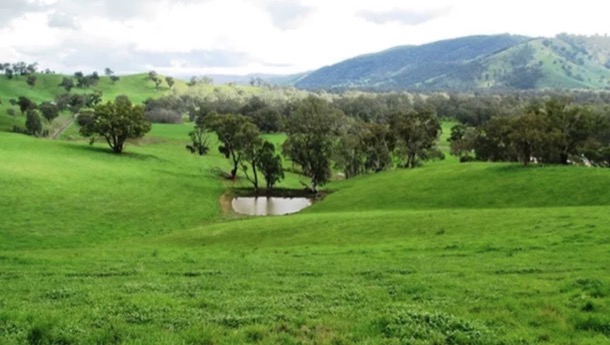
The Big Romance
So now we have three properties along the Goulburn. James and Bridget Hamilton’s Cremona and John McCormack’s Balham Hill, both near Molesworth, and James McCormack’s Tallarook House, twelve miles away.
The Hamilton girls, Grace, Johanna and Kate probably had met the McCormack boys, James, John Jnr and their brother Michael, at church. They were all Catholics.
The Hamiltons and McCormacks were a natural social fit: all pasturalists and Catholics of Irish extraction.
Archbishop Little tells us that the “Hamilton girls” stabled their horses at Tallarook House when catching or meeting the trains, and “made eyes at the McCormack boys”.
The roads between the Upper Goulburn and the railhead at Tallarook, had been completed by 1880, and the railway from Tallarook to Yea was being built from 1883. So we suppose that the road from the Upper Goulburn to Tallarook would have been a substantial one, about the time the girls were using it. Tallarook was where farm produce, etc was taken to put on the train for the markets in Melbourne.
But it’s a long way from Molesworth to Tallarook. Were they driven in a carriage of some sort, accompanied by workers from Cremona? Did they ride their own horses all that way? It was too far for a day trip. Where did they stay? And had the Hamilton girls’ parents met the McCormack boys’ parents, who lived quite a long way away, at Beveridge?
It’s a love story we can only speculate about.
But, ultimately, three Hamilton girls married three McCormack boys.
The most important to us, was Johanna Hamilton, later called Joan, our great grandmother, who married John McCormack Jnr of Balham Hill, in 1888.
Her sister, Grace, married James McCormack of Tallarook House in 1890
And Kate was the third sister, who married Michael McCormack. They settled initially in Berwick, and later Benalla.
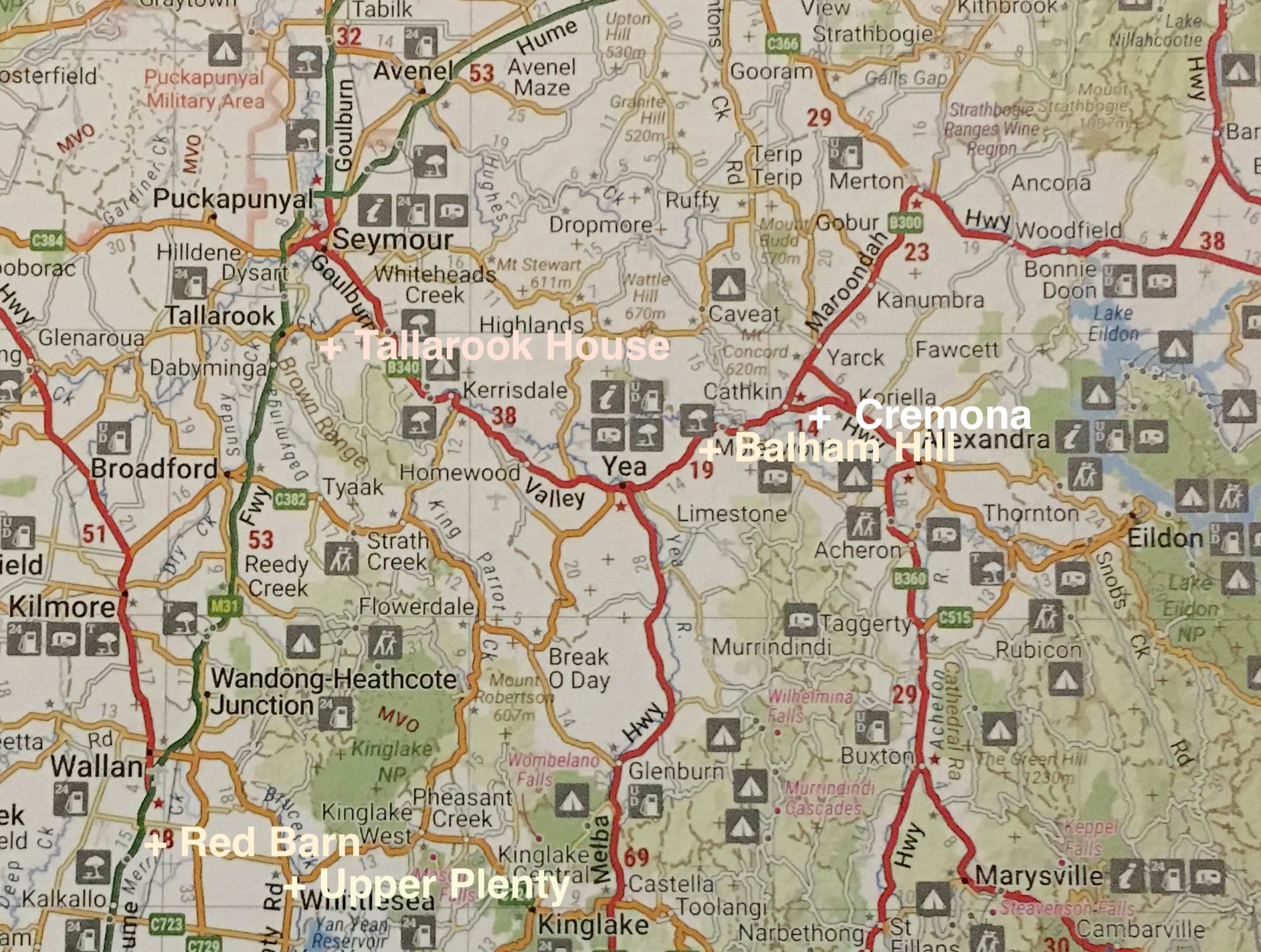
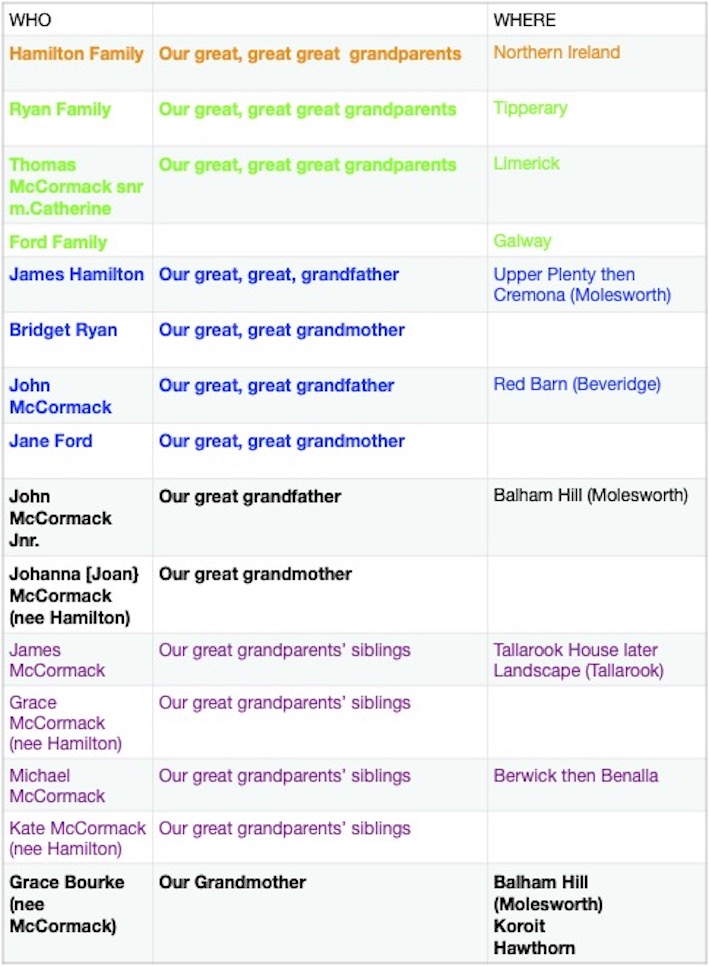
It took weeks to piece together the snippets of information we had. We doubled checked information, discarded red herrings, created a timeline. We complained about the way names appeared and reappeared in different generations. We cut and pasted a colour coded chart. Finally, gradually, the stories came into focus in our minds.
Our story begins in Ireland.
Four families: McCormacks, Fords, Hamiltons and Ryans
Three of the families, the McCormacks. the Fords and the Ryans, all Catholics, all emigrated about 1848 from Southern Ireland: Limerick, Galway and Tipperary
The fourth family, the Hamiltons, were Protestants, of Scottish Irish heritage. They emigrated from Antrim, Northern Ireland, also in 1848.
The Northern Irish Hamiltons arrived with some money, ready to buy land. But
our Southern IrIsh were probably driven out by the general economic turmoil and devastation caused by the Irish Potato Famine of 1845-1852.
At that time, the vast majority of the Irish Catholic population had little or no access to land ownership and many lived in appalling poverty.
Ninety percent of the land in Ireland was owned by Protestant landowners, who rented it out in small parcels to Irish tenant farmers. Already poor and dependent on the potato crop, Irish families starved when successive harvests failed, due to Potato Blight. As a result, Irish people emigrated in large numbers, land hungry and ready to and make their fortunes.
The colony the McCormacks, Fords, Hamiltons and Ryans arrived and settled in, had been ‘opened up’ by the squatters coming down from north of the Murray and inland from Portland. The Aboriginal tribes had been largely dispossessed, vast fortunes had been made, and the landed aristocracy had emerged as a powerful force in the burgeoning colony.
It is both expected and fascinating to see our Irish immigrant forbears’ land acquisition and prosperity mirrored, in the opening up of land for settlement in Victoria. This took place over several decades, primarily through a series of land acts, designed to break up the vast holdings of the squatters and encourage agricultural development, population growth, and the establishment of communities.
Between 1865 and 1890 Land Acts enabled land to be acquired at a fair price, and paid off in instalments. Specified improvements had to be made such as fencing, clearing and cultivation.
As we will see, our Irish families also benefitted from the growth and prosperity stemming from the Gold Rush. In 1851 gold was discovered in Ballarat, leading to the 1850s Gold Rush, a transformative event in Victorian history.
The colony grew rapidly in both population and economic power and our families, among others, took full advantage of the opportunities offered.
They set about the serious business of acquiring property supplying the new, lucrative, growing market with their produce. Country towns around them grew and with increased wealth, substantial civic buildings and churches were built. Railways and roads were constructed providing quicker and easier access to markets and facilitating social and family connections.
It would have been an exciting time for our four families, as they bought and developed their land holdings and participated in the civic life of the Colony of Victoria, with its own Lieutenant-Governor and elected Victorian Legislative Council.
During the first fifteen years after arriving in the colony, our four Irish Families became two couples.
1 James Hamilton and Bridget Ryan
The protestant Hamilton family from Northern Ireland comprised only a mother and son. We know that James Hamilton’s father had recently died. James was in his late teens, when he and his mother emigrated to Port Phillip, with enough capital to acquire a property in the colony. They chose Upper Plenty, which at that time was a rural area.
The Ryan family also emigrated about 1848.
About seven years later, in 1855, James Hamilton married Bridget Ryan. Bridget was a Catholic. Sue and I know something of this quandary, being daughters of a similar “mixed marriage”. The wedding was held on a property “Richland” near the Hamilton’s place at Upper Plenty. The property belonged to Mr David Johnston
Archbishop Little, who is also related to these four families and has written about them, has a bit to say about this marriage:
“… the marriage of James and Bridget was a truly valid Catholic marriage in the eyes of the Church.”
What he means here is that James would have agreed to the children of the marriage being brought up Catholics. He certainly followed through with this, even driving his wife and children to church on Sundays. Two of their daughters later became nuns.
James and Bridget stayed on for a further twelve years in Upper Plenty, where the first six of their children were born. These children included Charles, Grace, Johanna and Kate. Johanna was our Great Grandmother.
Then, in 1866, they acquired “Cremona Estate”, near present day Molesworth. They ran dairy and beef cattle and grew cereals on the rich
river flats.
Cremona homestead was "situated on the southern concave side of a great sweeping arc of the Goulburn river ….. it fronts the Whanregarwen road distant some three miles east from the present township of Molesworth" 1866:

Six further children, another five of them girls, were born at Cremona, before Bridget’s death, at the age of 56, in 1889.
Archbishop Little writes glowingly of life at Cremona, and of the three eldest Hamilton girls in particular. He describes them as “charming, refined, eligible and capable young ladies.” He describes the children’s education. An in-house private tutor taught them Art, Music and Painting, as well as academic subjects. But they all helped out on the farm as well, including the older girls, Grace, Johanna and Kate.
2 John McCormack Snr and Jane Ford
We don’t know the initial activities of the McCormack and Ford families, until, in 1850, two years after landing in Port Phillip, John McCormack (Senior) married Jane Ford at St Francis Church on the corner of Lonsdale and Elizabeth streets in Melbourne. Both had been in their late twenties and unmarried when they emigrated.
St Francis church today, the oldest still operating Catholic church in Victoria:

The couple settled near present day Beveridge, renting a property “Red Barn”. The property was very near the main road from Melbourne to Sydney. The family worked hard and developed a dairy herd, specialising in cheese, which they initially sold to passing diggers on their way to the goldfields.
Red Barn Lane today:

There was money to be made, so much, that the couple were later able to settle their sons on properties along the Goulburn River.
The first, of these, in 1876, was the eldest, James McCormack, then aged 18. The property, called Tallarook House, (later renamed Landscape), was at Tallarook, a hundred kilometres from Mebourne. James was unmarried at this stage and Tallarook House remained without a mistress for a further twelve years. Clearly, James was very involved in the community. He was elected as a councillor for the Shire of Seymour in 1887.
"Landscape" today:

"Landscape" interior:

The second McCormack to be settled along the Goulburn River, was John Jnr. That property, acquired in 1886, called Balham Hill, was near Molesworth. John also became a councillor, for Yea Shire.
Balham Hill:

Balham Hill property:

The Big Romance
So now we have three properties along the Goulburn. James and Bridget Hamilton’s Cremona and John McCormack’s Balham Hill, both near Molesworth, and James McCormack’s Tallarook House, twelve miles away.
The Hamilton girls, Grace, Johanna and Kate probably had met the McCormack boys, James, John Jnr and their brother Michael, at church. They were all Catholics.
The Hamiltons and McCormacks were a natural social fit: all pasturalists and Catholics of Irish extraction.
Archbishop Little tells us that the “Hamilton girls” stabled their horses at Tallarook House when catching or meeting the trains, and “made eyes at the McCormack boys”.
The roads between the Upper Goulburn and the railhead at Tallarook, had been completed by 1880, and the railway from Tallarook to Yea was being built from 1883. So we suppose that the road from the Upper Goulburn to Tallarook would have been a substantial one, about the time the girls were using it. Tallarook was where farm produce, etc was taken to put on the train for the markets in Melbourne.
But it’s a long way from Molesworth to Tallarook. Were they driven in a carriage of some sort, accompanied by workers from Cremona? Did they ride their own horses all that way? It was too far for a day trip. Where did they stay? And had the Hamilton girls’ parents met the McCormack boys’ parents, who lived quite a long way away, at Beveridge?
It’s a love story we can only speculate about.
But, ultimately, three Hamilton girls married three McCormack boys.
The most important to us, was Johanna Hamilton, later called Joan, our great grandmother, who married John McCormack Jnr of Balham Hill, in 1888.
Her sister, Grace, married James McCormack of Tallarook House in 1890
And Kate was the third sister, who married Michael McCormack. They settled initially in Berwick, and later Benalla.


Comments
Grace McCormack, our other grandmother.
25 05 16 17:04 Filed in: Jim
Until last week we knew very little about our paternal Grandmother, Grace. We both had the feeling from our father that she had been a “somebody”. I remember him referring to her as “Gracie McCormack”, as if that meant something special. We knew that, as the doctor’s wife in Koroit, she had been an important person. Then we did a little research:
Grace McCormack was born in 1893 at the family home, called Balham Hill in Molesworth, near Yea. This is only nineteen kilometres from Sue and Jono's new property Billy Goat Hill.
Grace's father, John and mother Johanna, were highly respected and wealthy members of the community, who had bought the huge grazing property, nearly 15,000 acres, in 1886.
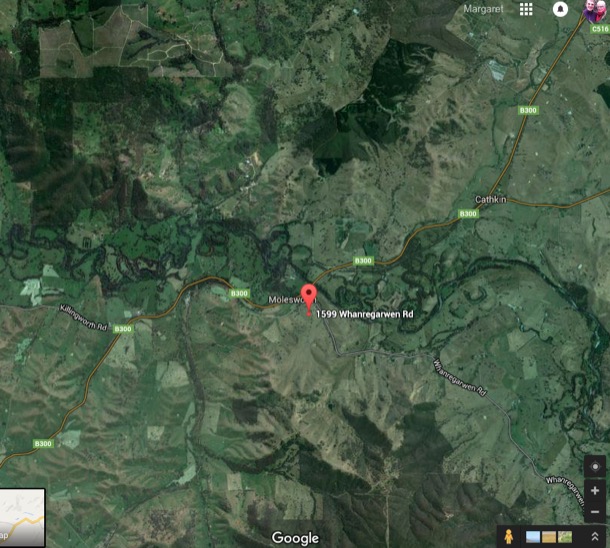
The house, still there today, had been built by one of the first white settlers in the area, Edward Cotton. It was near the Goulburn River, built of bricks made on the property.
The address is 1599 Whanregarwen Road MOLESWORTH
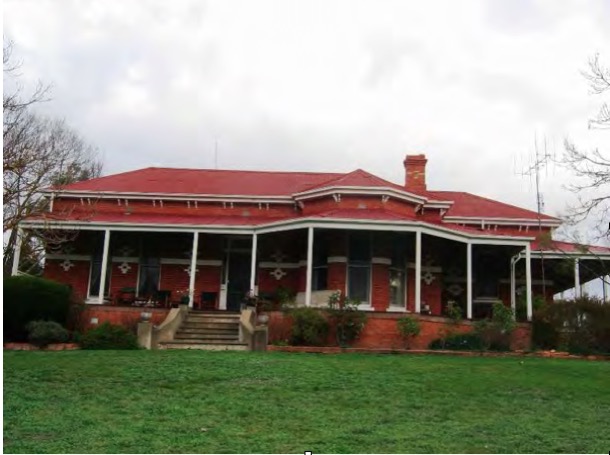
When he first arrived in the district he (Edward Cotton, who later published a book about Australian birds) wrote of the view over the valley from the Balham Hill homestead in his correspondence." I was much pleased with the beauty of the spot. The trees are rather thinly scattered over the flat, and there are extensive lagoons”. ”White cockatoos, king parrots, parakeets, eagle hawks, several species of honey-suckers and numerous tribes of smaller birds, including the bellbird, the superb warbler, etc., were plentifully scattered about this station. Ducks, black swans, divers, kingfishers, herons were constantly seen on or about the lagoons”.
HISTORY OF BALHAM HILL (from the Shire of Murrindindi Heritage Report)
The original homestead was built for Edward Cotton in 1842 or '43 using bricks made on the property. A report on the request for a pre-emptive right of June 1854 refers to a brick home, woolshed, outhouses and stables. Edward Cotton, the first squatter of Balham Hill, was born in 1803 Balham Hill, Clapham Common near London. Despite his ambitions, he failed as a pastoralist and sold Balham Hill in 1848. He died from drowning at Moorabbin in 1860, one a week after being suspended from his position as Registrar (Chief Clerk) of the County Court for 'extravagance and financial mismanagement'. In 1886 the property was sold by William Merry to John McCormack. He and his wife Johanna had five children, one of whom, Aloysius, died as an infant. The remaining children, Jane, Grace, Leo and Cyril grew up at Molesworth and attended Molesworth State School. In the early 1900s John McCormack rebuilt the homestead, retaining and incorporating into the new building some of Cotton's original homestead. The front rooms and hall were built for McCormack. The E-W passage is believed to be the front verandah of the original building, and there may have been many more rooms at the rear. During the McCormacks' time there was a circular drive at the front which was lost when road works altered the entrance. In 1930, following the death of John McCormack, the property was divided. Leo retained Balham Hill and married Zillah Maling. In 1942 Leo sold Balham Hill and moved to Melbourne. Cyril, who married Josephine Conlan in June 1930, took over a large area near Cottons Pinch and a home was built on this section. The property was named Alencon after a village in northern France. An early large orchard on the east side of the house, which includes the establishment of a Mulberry tree, was still in existence in 1994. An early rose garden once occupied the west side.
It is believed that the house originally had 17 rooms, but some of them were removed in the mid-20th century.
Births, deaths and weddings have all taken place at Balham Hill. Notably, Clara Ridd was born there during the 1870 flood. It is thought Balham Hill provided accommodation to travellers en route to the north east.
Grace was the second child. She had an older sister, Jean and three younger brothers, one of whom, Aloysius, died aged only ten months. He is buried in the Yea Cemetery. The other two boys were called Leo and Cyril. The four children all attended Molesworth State School.
John was a Justice of the Peace, a community leader, who could sign official documents and witness things for people. He donated the land for the Molesworth Community Hall.
John and Johanna had the house remodelled in the early 1900s. It had 17 rooms and a circular driveway.
The children were sent away to boarding school for their secondary education. The boys probably went to Xavier College, the girls to the Convent of Mercy in Fitzroy:
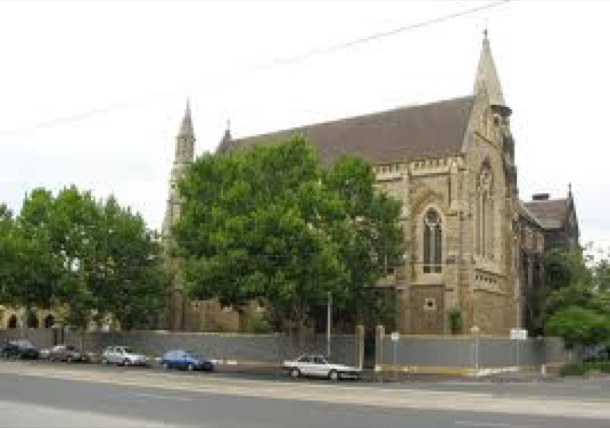
Jean was married almost exactly one month before the First World War began, in 1914: a grand affair at St Patrick’s Cathedral. Grace was her bridesmaid. The newspaper coverage of this social event is worth a read:
MR. T. M. B. COFFEY TO MISS J. McCORMACK.
The marriage of Mr. T. M. B. Coffey, third son of the late John Coffey and Mrs. Coffey, of “Kewell," Riversdale Road, Hawthorn, and Miss Jean McCormack, elder daughter of Mr. John McCormack, of "Balham Hill” Molesworth was celebrated at St. Patrick's Cathedral, Melbourne, on 27th May.
The Rev. Father O'Reilly (Castlemaine) officiated. He was assisted by the Rev. Father Ellis. The altar was beautifully decorated with white flowers. Miss Anderson was at the organ, and played Lohengrin's Wedding March and other beautiful music. The bride, who was given away by her father, wore a gown of soft Oriental satin, gracefully draped in straight
lines, and veiled with a short tunic of fine silk shadow lace. The beautiful court train was lined with shell pink, and finished with true lovers' knots and orange blossom. The Angel sleeves were caught and weighted with pearl tassels. The crossed bodice was of pearl embroidery, veiled with silk shadow lace. A veil of beautiful old Limerick lace (lent by the nuns) was worn, and a shower bouquet of white azaleas and fern was carried. The bridesmaid (Miss Grace McCormack) was frocked in dainty ivory crepe-de chine, the tunic of soft ninon, edged with marabout. The bodice, of soft shadow lace, was veiled with ninon, and finished with a sash of rose-pink velvet. The black velvet hat was wreathed with small winter berries and forget-me-nots. A bouquet of La France roses was carried. The train-bearers were Miss Kathleen McCormack (bride's god-child and cousin) and Miss Margaret Armond (bridegroom's god-child and cousin). They wore dainty little early Victorian dresses of white crepe-de^chine, with empire sashes, of ninon, the neck and sleeves prettily finished with white marabout. Their ninon capes were set with trails of pale pink, and they carried 1830 bouquets of small pink roses and silver bags (gifts of bridegroom). The bridegroom's gift to the bride was a pianola piano; to bridesmaids, Nellie Stewart bangle; bride to bridegroom, beautifully fitted dressing case. Mr. Leo. McCormack (brother of bride) was best man. The bride's mother was gowned in black cashmere de soie, the skirt gracefully draped with beautiful Chantilly lace; the bodice of fine black lace, embroidered in gold, and finished with soft white tulle. A black velvet hat, set with ostrich plumes, was worn, and a bouquet of violets was carried. The bridegroom's mother and sister were unable to be present, being at present on a visit to Dr. Coffey, in Dublin. A reception was held at, the Grand Hotel, followed by a wedding luncheon to about seventy guests.
Later the bride and bridegroom left for Sydney, en route to New Zealand. The bride travelled in blue coat and skirt, rolled back with collar of white cloth. A black velvet hat, set with a white plume was also worn. The presents were numerous and costly, and included several substantial cheques.
So Grace was given present of a plain gold "Nellie Stewart bangle" These had become a popular fashion accessory for young Australian women in the late 19th and early 20th centuries. Usually worn on the upper arm, they were an emulation of Nellie Stewart's style. (a singing celebrity of the time)
Four years later, at the end of a gruelling four years of war, Grace herself married Hugh Stanislaus Bourke. She was twenty-five. One can’t help but speculate about those four years. How many friends did she lose? Perhaps even an earlier sweetheart.
We know her two brothers survived, because the land was divided between them when their father died in 1930.
Their wedding was a less grand affair, though still held at St Pat’s Cathedral. (Note the excitement of the aeroplane.)
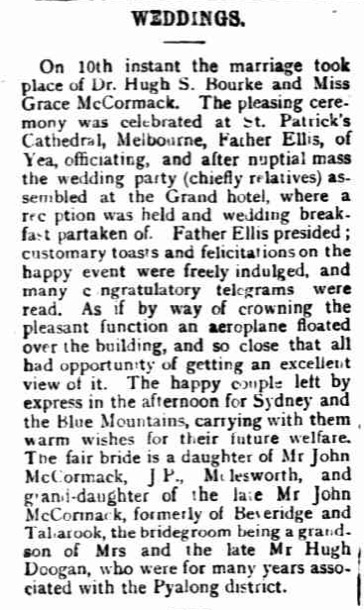
On 10th instant the marriage took place of Dr. Hugh S. Bourke and Miss Grace McCormack. The pleasing ceremony was celebrated at St. Patrick’s Cathedral, Melbourne, Father Ellis, of Yea, officiating, and after nuptial mass the wedding party (chiefly relatives) assembled at the Grand hotel, where a reception was held and wedding breakfast partaken of.
Father Ellis presided; customary toasts and felicitations on the happy event were freely indulged, and many congratulatory telegrams were read.
As if by way of crowning the pleasant function an aeroplane floated over the building, and so close that all had opportunity of getting an excellent view of it. The happy couple left by express in the afternoon for Sydney and the Blue Mountains, carrying with them warm wishes for their future welfare. The fair bride is a daughter of Mr John McCormack, J.P., Molesworth, and granddaughter of the late Mr John McCormack, formerly of Beveridge and Tallarook, the bridegroom being a grandson of Mrs and the late Mr Hugh Doogan, who were for many years associated with the Pyalong district.
Hugh had been registered as a doctor in 1907, and was, by 1918, practising in the western Victorian town of Koroit, where Grace and Hugh raised their three children.
They moved to 88 Glenferrie Road Hawthorn, home and GP surgery, during the 1930s, and stayed there until Hugh’s death in 1951, when the practice was taken over by their eldest son John.
Grace, then aged 58, moved nearby and then to Urquhart Street, Hawthorn, where we can remember visiting her, when we were children.
And a little bit about Grace's paternal grandparents:
Grace comes from quite a line of early Victorian settlers. Grace’s grandfather, also called John McCormac, and her grandmother Grace Bridget McCormack, first rented a dairy property in Beveridge called Red Barn, and then acquired other properties in the Goulburn Valley, for their sons.
The property at Tallarook, formerly Tallarook House, was later called ‘Landscape’ . It was a large gazing property, with Goulburn River frontage. Grace’s grandmother died at ‘Landscape' having spent 69 of her 83 years in the district.
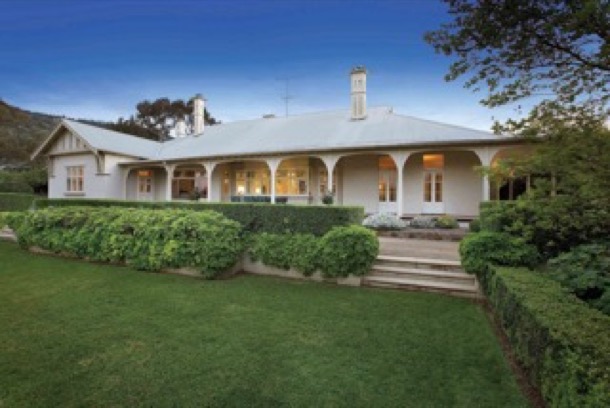
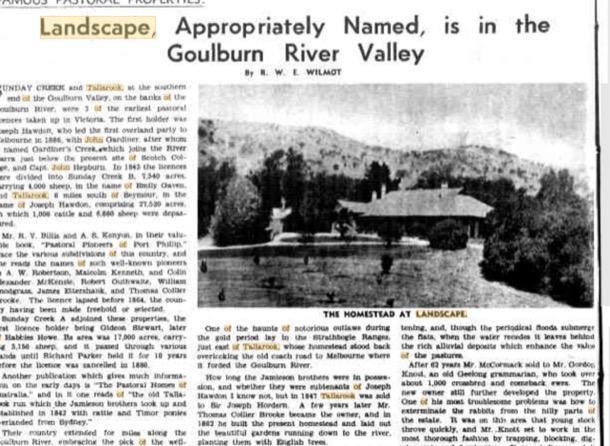
A section of this article reads:
When Tallarook was still further subdivided in 1867, the homestead block of 3000 acres was purchased by Mr J McCormack, who named his property “Landscape”. It was only natural that in sixty years, a district so favoured by Nature within fifty-five miles of Melbourne, on the main highway from Melbourne to Sydney, should progress, and in that development Landscape shared.
The Goulburn River, with its rich alluvial flats, flanked by slopes between the frontages and the granite hills, make up an ideal property for fattening, and, though the periodical floods submerge the flats, when the water recedes it leaves behind the rich alluvial deposits which enhance the values of the pastures.
And, as an amazing postscript, Jono remembers that his mother, Janie, was school friends with a girl called Janet Essington-Lewis. Her father was the head of BHP and owned Landscape in the 1930s. Janie used to go riding at Landscape with Janet.
Grace McCormack was born in 1893 at the family home, called Balham Hill in Molesworth, near Yea. This is only nineteen kilometres from Sue and Jono's new property Billy Goat Hill.
Grace's father, John and mother Johanna, were highly respected and wealthy members of the community, who had bought the huge grazing property, nearly 15,000 acres, in 1886.

The house, still there today, had been built by one of the first white settlers in the area, Edward Cotton. It was near the Goulburn River, built of bricks made on the property.
The address is 1599 Whanregarwen Road MOLESWORTH

When he first arrived in the district he (Edward Cotton, who later published a book about Australian birds) wrote of the view over the valley from the Balham Hill homestead in his correspondence." I was much pleased with the beauty of the spot. The trees are rather thinly scattered over the flat, and there are extensive lagoons”. ”White cockatoos, king parrots, parakeets, eagle hawks, several species of honey-suckers and numerous tribes of smaller birds, including the bellbird, the superb warbler, etc., were plentifully scattered about this station. Ducks, black swans, divers, kingfishers, herons were constantly seen on or about the lagoons”.
HISTORY OF BALHAM HILL (from the Shire of Murrindindi Heritage Report)
The original homestead was built for Edward Cotton in 1842 or '43 using bricks made on the property. A report on the request for a pre-emptive right of June 1854 refers to a brick home, woolshed, outhouses and stables. Edward Cotton, the first squatter of Balham Hill, was born in 1803 Balham Hill, Clapham Common near London. Despite his ambitions, he failed as a pastoralist and sold Balham Hill in 1848. He died from drowning at Moorabbin in 1860, one a week after being suspended from his position as Registrar (Chief Clerk) of the County Court for 'extravagance and financial mismanagement'. In 1886 the property was sold by William Merry to John McCormack. He and his wife Johanna had five children, one of whom, Aloysius, died as an infant. The remaining children, Jane, Grace, Leo and Cyril grew up at Molesworth and attended Molesworth State School. In the early 1900s John McCormack rebuilt the homestead, retaining and incorporating into the new building some of Cotton's original homestead. The front rooms and hall were built for McCormack. The E-W passage is believed to be the front verandah of the original building, and there may have been many more rooms at the rear. During the McCormacks' time there was a circular drive at the front which was lost when road works altered the entrance. In 1930, following the death of John McCormack, the property was divided. Leo retained Balham Hill and married Zillah Maling. In 1942 Leo sold Balham Hill and moved to Melbourne. Cyril, who married Josephine Conlan in June 1930, took over a large area near Cottons Pinch and a home was built on this section. The property was named Alencon after a village in northern France. An early large orchard on the east side of the house, which includes the establishment of a Mulberry tree, was still in existence in 1994. An early rose garden once occupied the west side.
It is believed that the house originally had 17 rooms, but some of them were removed in the mid-20th century.
Births, deaths and weddings have all taken place at Balham Hill. Notably, Clara Ridd was born there during the 1870 flood. It is thought Balham Hill provided accommodation to travellers en route to the north east.
Grace was the second child. She had an older sister, Jean and three younger brothers, one of whom, Aloysius, died aged only ten months. He is buried in the Yea Cemetery. The other two boys were called Leo and Cyril. The four children all attended Molesworth State School.
John was a Justice of the Peace, a community leader, who could sign official documents and witness things for people. He donated the land for the Molesworth Community Hall.
John and Johanna had the house remodelled in the early 1900s. It had 17 rooms and a circular driveway.
The children were sent away to boarding school for their secondary education. The boys probably went to Xavier College, the girls to the Convent of Mercy in Fitzroy:

Jean was married almost exactly one month before the First World War began, in 1914: a grand affair at St Patrick’s Cathedral. Grace was her bridesmaid. The newspaper coverage of this social event is worth a read:
MR. T. M. B. COFFEY TO MISS J. McCORMACK.
The marriage of Mr. T. M. B. Coffey, third son of the late John Coffey and Mrs. Coffey, of “Kewell," Riversdale Road, Hawthorn, and Miss Jean McCormack, elder daughter of Mr. John McCormack, of "Balham Hill” Molesworth was celebrated at St. Patrick's Cathedral, Melbourne, on 27th May.
The Rev. Father O'Reilly (Castlemaine) officiated. He was assisted by the Rev. Father Ellis. The altar was beautifully decorated with white flowers. Miss Anderson was at the organ, and played Lohengrin's Wedding March and other beautiful music. The bride, who was given away by her father, wore a gown of soft Oriental satin, gracefully draped in straight
lines, and veiled with a short tunic of fine silk shadow lace. The beautiful court train was lined with shell pink, and finished with true lovers' knots and orange blossom. The Angel sleeves were caught and weighted with pearl tassels. The crossed bodice was of pearl embroidery, veiled with silk shadow lace. A veil of beautiful old Limerick lace (lent by the nuns) was worn, and a shower bouquet of white azaleas and fern was carried. The bridesmaid (Miss Grace McCormack) was frocked in dainty ivory crepe-de chine, the tunic of soft ninon, edged with marabout. The bodice, of soft shadow lace, was veiled with ninon, and finished with a sash of rose-pink velvet. The black velvet hat was wreathed with small winter berries and forget-me-nots. A bouquet of La France roses was carried. The train-bearers were Miss Kathleen McCormack (bride's god-child and cousin) and Miss Margaret Armond (bridegroom's god-child and cousin). They wore dainty little early Victorian dresses of white crepe-de^chine, with empire sashes, of ninon, the neck and sleeves prettily finished with white marabout. Their ninon capes were set with trails of pale pink, and they carried 1830 bouquets of small pink roses and silver bags (gifts of bridegroom). The bridegroom's gift to the bride was a pianola piano; to bridesmaids, Nellie Stewart bangle; bride to bridegroom, beautifully fitted dressing case. Mr. Leo. McCormack (brother of bride) was best man. The bride's mother was gowned in black cashmere de soie, the skirt gracefully draped with beautiful Chantilly lace; the bodice of fine black lace, embroidered in gold, and finished with soft white tulle. A black velvet hat, set with ostrich plumes, was worn, and a bouquet of violets was carried. The bridegroom's mother and sister were unable to be present, being at present on a visit to Dr. Coffey, in Dublin. A reception was held at, the Grand Hotel, followed by a wedding luncheon to about seventy guests.
Later the bride and bridegroom left for Sydney, en route to New Zealand. The bride travelled in blue coat and skirt, rolled back with collar of white cloth. A black velvet hat, set with a white plume was also worn. The presents were numerous and costly, and included several substantial cheques.
So Grace was given present of a plain gold "Nellie Stewart bangle" These had become a popular fashion accessory for young Australian women in the late 19th and early 20th centuries. Usually worn on the upper arm, they were an emulation of Nellie Stewart's style. (a singing celebrity of the time)
Four years later, at the end of a gruelling four years of war, Grace herself married Hugh Stanislaus Bourke. She was twenty-five. One can’t help but speculate about those four years. How many friends did she lose? Perhaps even an earlier sweetheart.
We know her two brothers survived, because the land was divided between them when their father died in 1930.
Their wedding was a less grand affair, though still held at St Pat’s Cathedral. (Note the excitement of the aeroplane.)

On 10th instant the marriage took place of Dr. Hugh S. Bourke and Miss Grace McCormack. The pleasing ceremony was celebrated at St. Patrick’s Cathedral, Melbourne, Father Ellis, of Yea, officiating, and after nuptial mass the wedding party (chiefly relatives) assembled at the Grand hotel, where a reception was held and wedding breakfast partaken of.
Father Ellis presided; customary toasts and felicitations on the happy event were freely indulged, and many congratulatory telegrams were read.
As if by way of crowning the pleasant function an aeroplane floated over the building, and so close that all had opportunity of getting an excellent view of it. The happy couple left by express in the afternoon for Sydney and the Blue Mountains, carrying with them warm wishes for their future welfare. The fair bride is a daughter of Mr John McCormack, J.P., Molesworth, and granddaughter of the late Mr John McCormack, formerly of Beveridge and Tallarook, the bridegroom being a grandson of Mrs and the late Mr Hugh Doogan, who were for many years associated with the Pyalong district.
Hugh had been registered as a doctor in 1907, and was, by 1918, practising in the western Victorian town of Koroit, where Grace and Hugh raised their three children.
They moved to 88 Glenferrie Road Hawthorn, home and GP surgery, during the 1930s, and stayed there until Hugh’s death in 1951, when the practice was taken over by their eldest son John.
Grace, then aged 58, moved nearby and then to Urquhart Street, Hawthorn, where we can remember visiting her, when we were children.
And a little bit about Grace's paternal grandparents:
Grace comes from quite a line of early Victorian settlers. Grace’s grandfather, also called John McCormac, and her grandmother Grace Bridget McCormack, first rented a dairy property in Beveridge called Red Barn, and then acquired other properties in the Goulburn Valley, for their sons.
The property at Tallarook, formerly Tallarook House, was later called ‘Landscape’ . It was a large gazing property, with Goulburn River frontage. Grace’s grandmother died at ‘Landscape' having spent 69 of her 83 years in the district.


A section of this article reads:
When Tallarook was still further subdivided in 1867, the homestead block of 3000 acres was purchased by Mr J McCormack, who named his property “Landscape”. It was only natural that in sixty years, a district so favoured by Nature within fifty-five miles of Melbourne, on the main highway from Melbourne to Sydney, should progress, and in that development Landscape shared.
The Goulburn River, with its rich alluvial flats, flanked by slopes between the frontages and the granite hills, make up an ideal property for fattening, and, though the periodical floods submerge the flats, when the water recedes it leaves behind the rich alluvial deposits which enhance the values of the pastures.
And, as an amazing postscript, Jono remembers that his mother, Janie, was school friends with a girl called Janet Essington-Lewis. Her father was the head of BHP and owned Landscape in the 1930s. Janie used to go riding at Landscape with Janet.

